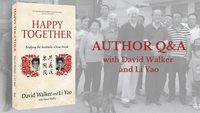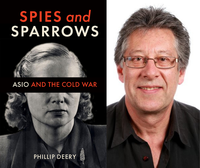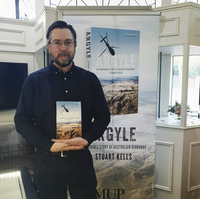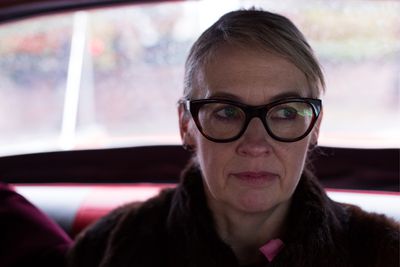Graeme Davison's speech launching The Work of History edited by Peter Beilharz and Sian Supski
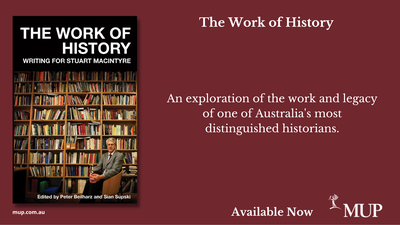
The Work of History: Writing for Stuart Macintyre, Edited by Peter Beilharz and Sian Supski
(Melbourne University Press, Carlton, 2022)
Graeme Davison (AO FAHA FASSA FFAHS FRHSV, Emeritus Sir John Monash Distinguished Professor)
Melbourne Athenaeum Library, 15 July 2022
In the months since his death, we have only become more conscious of the immense gap Stuart Macintyre leaves in our intellectual and civic life. So it’s with a mixture of sadness and deep admiration that we celebrate the publication of this tribute from his friends.
Peter and Sian conceived the project, and it was largely completed, while Stuart was still with us. We all looked forward to an occasion like this when we would present its result to him. Characteristically, he wanted the focus to be on the work rather than the man, in the hope that it would foster a continuing conversation about the things he most cared about. That conversation will continue, and we all hope that this book will help to generate more of it, but, alas, it will be without Stuart himself. It’s a consolation that he knew it was coming and had an opportunity to read it in manuscript but we can’t but regret that he’s not here with us in the room.
Many words– true and heartfelt words– have already been spoken and written about Stuart and his remarkable legacy. Among them, I particularly remember those spoken by his daughter Mary on the day we farewelled him at Ormond College. ‘His mind never rested’, she said. My recollection is that she said it, as though for emphasis, not once but twice. ‘His mind never rested’. Perhaps only someone who knew him closely, and in his domestic as well as his public life, could bear such witness to the constancy of his mental labour.
As Peter and Sian acknowledge, there was indeed an element of the Protestant ethic in Stuart’s fierce dedication to the task, but in my observation at least, his work was also his delight. It was liberating and life-giving to him and to others. In a famous essay, Max Weber, who knew both the Protestant ethic and the vocation of the intellectual from the inside, wrote perceptively of the ‘inner devotion to the task’ that lifts the inquirer to ‘the height and dignity of the subject he aspires to serve.’ It was something like that, I think, that we detected in Stuart’s unresting mind. In the deadtime between meetings, even in the meetings themselves, he was thinking about the paragraph he would write when he got home. Flying to interstate or overseas meetings he was reading and commenting on his colleagues’ or students’ work. When he ran with his friends, he maintained a constant conversation. Most of my own conversations with Stuart were in the course of our work, but – as many others recall in this book– discussion of the project in hand seamlessly moved into news of mutual friends, books or articles we had read, the state of our discipline or the academy more generally, and to current national and international politics. All this, in the best sense, was work– what, after Marx, we might describe as unalienated labour– not work imposed by a master from without but directed from within and towards a social or civic purpose.
So, while a lot of Stuart’s work was in labour history, or at the service of political Labor, I think that the title of this book The Work of History has a deeper significance. I thought I knew Stuart and his writing pretty well but one of the delights of reading these essays is a renewed appreciation of the sheer breadth and diversity of his friendships and engagements. We get a fresh view of young Stuart from his Cambridge friends, Geoff Eley and Kevin Morgan and of his strong trans-Tasman connections from Philippa Mein-Smith and Len Richardson, of his collegial relationships from Pat Grimshaw and his comradeship with fellow labour historians Peter Love, Philip Deery and Julie Kimber. Alison Bashford, Kate Darian-Smith and I write of his genius as an editor and collaborator in the Oxford and Cambridge histories and companions. Sheila Fitzpatrick notes his ability to write of the living and the dead, as though they inhabited the same space. Through them all, several themes recur– generosity, astonishing breadth of knowledge and recall of detail, rapid, skillful and discerning editing and a delight in doing history together.
I am sure I won’t the last reader or reviewer to remark the striking cover image of the book. Here is Stuart– grey haired, bespectacled, correctly attired in jacket and tie, hands clenched around his knees, gazing thoughtfully towards us with his beloved library towering, shelf upon shelf, above him. Much of this book is about Stuart the radical historian, the historian of Communism and the lifelong seeker of a more just and equal society. But the cover image reminds of another Stuart, the traditionalist. If you are going to be on Left, he once told one of his Cambridge friends, Ludmilla Jordanova, you should always dress respectably. His taste in literature – John Buchan for example – was quite conservative. He had the conservative’s esteem for institutions from the Hawthorn Football Club and Ormond College to the Australian Labor Party and the great public cultural institutions like the National Library and the National Archives he served. As a historian, he was methodologically quite conservative: close reading of the archival record, clear, elegant prose, nothing extraneous, ostentatious, self-referential or needlessly abstract.
And then, that wonderful library: like the working class autodidacts who feature so strongly in his histories of Communism, Stuart was very much a man of the book. From the fourteen year old who took out a subscription to Hansard to the mature historian who seemed to have read everything, Stuart lived and breathed the conviction that the best that humans could think or feel was somehow best distilled in the sustained stories and arguments of a book. So it’s especially appropriate that we launch this book today in one of Melbourne’s oldest libraries. Stuart was aware that the book was somewhat imperiled species. His entry on Books in the Oxford Companion to Australia History (published 1998) concludes with gloomy reflections on the ‘inability of the book to hold the attention of students habituate to other forms of information and entertainment.’ So, as much as we may share his doubts, there really was no other proper way to celebrate the life than in the form of a book.
Perhaps he was conservative too, even in some aspects of his politics. Like the great liberals he wrote so about so perceptively in A Colonial Liberalism, he had a deep faith in the transformative power of education. Yet, as Carolyn Holbrook argues in her essay on Stuart’s most significant public role, as leader of the Keating Government’s Civics Expert Group, that project may have invested too much in education and too little in the skilled marketing and propaganda that might alone, in our market-oriented society, have effected a change in public values and attitudes towards the republic. Though I note, in his response to this volume, Stuart actually denies a primary role in initiating that project, admits only tepid support for civics education and even suggests that citizens have a right, if they so wish, to be inactive rather than, as he was himself, the very model of an engaged and selfless citizen.
It was perhaps in his writing on the history of the universities, notably their response to the Dawkins reforms, that Stuart offered his most acute reappraisal of the liberal educational ideal in which his own discipline, history, occupied such a pivotal position. The tensions between the Laborist aspirations to universal access, the liberal ideals of opportunity and excellence and the pervasive utilitarianism of Australian society that played out during those years shaped Stuart’s thinking, both as historian of the university and as university administrator. Simon Marginson’s essay is alert to both the national and international significance of these debates and his verdict on Stuart’s writing –‘ there has never been a better body of work on the antipodean university as an object of inquiry’–carries conviction.
Reading The Work of History, I came to a clearer idea of the continuities and shifts in Stuart’s historical practice. Several authors identify his short early book Winners and Losers as a precursor of themes worked out in his Oxford and Cambridge histories. Frank Bongiorno suggests that his work as whole can be read as series of variations on ‘the making of a distinctive Australian modernity’. His exploration on the distinctive qualities of Victorian liberalism and Australian Communism, as well as key institutions of the federal settlement, such as arbitration, might confirm that view. Yet there were significant shifts as well. In Cambridge, it seems, he was still working out his attachment to Althusser but by 1978, when he published ‘The Making of the Australian Working Class’ it was Althusser’s antagonist E.P. Thompson, who was the guiding light of his analysis. Geoff Bolton’s invitation to write a volume in the Oxford History of Australia seems to have been an important moment, in confirming his commitment to Australian history, just as the volume bridges the class analysis of his early books the national focus of the mature ones. With his return to Melbourne and elevation to the Scott Chair there is a stronger emphasis on the civic dimension of historical practice, and a revaluation of the Melbourne School of History, as the critic becomes a custodian, without quite losing his critical edge. When the History Wars erupted in the 1990s, the critique of historical orthodoxy came from the Right and in his account of the conflict – the most polemical of all his work–Stuart’s harshest words are not for the political position of his opponents but for their methods: ‘They obey only Rafferty’s rules. They caricature their opponents and impugn their motives . . . In their intimidation of the history profession they act as bullies.’
Stuart gave the later part of his life to two large projects: a history of Postwar Reconstruction and the second volume of his history of Australian Communism. It is natural that we should ask ourselves, at this critical juncture in our history, what lessons we might draw from them. Some might wonder why, having left the Communist Party behind, Stuart felt obliged to write, and in the face of personal difficulty, complete that second volume. Was it his personal code of honour, to fulfill the promise he had made to the former comrades who had entrusted the task to him? Was it, as Terry Irving suggests, that he was drawn to the subject because it posed questions that were left unresolved after his own youthful engagement with Communism? Whatever his aim, the result, as Ann Curthoys persuasively argues in her essay, was ‘an exemplary work of Thucydidean history’, ‘a tragedy of high ideals, misplaced loyalty, personal failings, at times dishonesty and skullduggery, a meditation on political imagination, ambition, fantasy and failure’. There are lessons, she says, for us too, but surely they are mostly sombre and cautionary ones.
Australia’s Boldest Experiment, on the other hand, as its title suggests, is a work in a different register, a tribute to the humane ideals, political skill, intelligent planning and fundamental decency of the men and some women who designed the postwar Australian settlement and delivered the country into the long period of prosperity that most of us, including Stuart, enjoyed in the 1950s and 60s. As Nick Brown notes in his essay, Stuart was gratified that members of the federal caucus invited him to discuss the themes of the book although how thoroughly they absorbed its lessons –it is a big book for busy people, after all– we may doubt. More recently Janet McCalman and others have pointed to his narrative, not as a blueprint for an Albanese government – for 2022 is not 1945– but as a powerful corrective to the neo-liberal narrative that even some Labor leaders uncritically ingested. Yet even here, as Nick shows, Stuart, the consummate historian, resists the temptation to hero-worship or to simplistic analogies between past and present. What he gave us was not a tract for the times but something more enduring: a deeply humane account of what, at their best, Australians are capable of making of their collective life.
It’s impossible, in a few words, to do justice to the riches of this volume, and I apologise to those whose essays I haven’t had time to mention. What does remain to me is, on behalf of us all, to say a word of warm appreciation to Peter and Sian who conceived this book, chose its theme, persuaded its subject to cooperate, engaged our publisher, edited our copy sympathetically and well, and introduced and closed the book appropriately. They end it with three counterfactuals. What if Stuart had joined the Liberal Party? What if he had stayed in England? What if he’d been a sociologist? Well, for all –even including the last, we are surely better off. Over all remains the hardest counterfactual – what more of light and learning might he have contributed if only his life had been longer.
So, Peter and Sian, we are all in your debt. I recognise my fellow contributors, although none of us really needed any persuasion to participate. Thanks too to MUP and especially to Nathan Hollier for whom, I feel sure, this was a labour of love. To Martha, Mary, Jessica and your families, I hope that the book may reflect back to you just a little of all that we have gained and learned from our friendship with Stuart. As I note at the end of my own contribution, ‘his intelligence, generosity and integrity continue to shine.’
